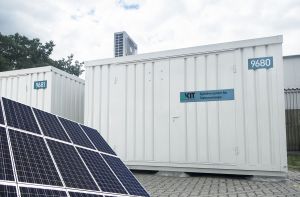A vital requirement of power generation from wind power and photovoltaics are energy storage systems that address the problem of fluctuating electricity supply from renewable sources.
 The new energy module of KIT(Image Credit: PCE/KIT)
The new energy module of KIT(Image Credit: PCE/KIT)
The Karlsruhe Institute of Technology (KIT) is involved in building many standalone power supply networks comprising solar cells, lithium-ion batteries, small wind power plants and power electronic components to demonstrate the balancing of load between the different sources during peak consumption.
The project which is dubbed as Competence E, is scheduled to complete the first stage with a modular power system of 50 kW capacity installed to the north of KIT campus by end of 2012. Coordinated by Dr. Andreas Gutsch, a battery screening was made worldwide to identify the best lithium-ion cells for stationary storage. The project’s first stage is expected to take care of the annual electricity requirements of a mid-sized company. The expertise gained from this will be employed to develop larger storage systems for industry and small ones for residences. The power from the solar cells will be augmented by wind power, especially in winter, from a wind generator suitable for regions experiencing weak winds. In addition to the lithium-ion battery, another important component of the stationary storage system is a power electronics system which requires only two hours for charging and discharging the lithium-ion batteries. The balancing of load is carried out such that solar and wind energy is stored in the battery during periods of weak load while energy from the photovoltaic cells, wind generator and battery is fed into the grid during periods of heavy load. The performance and life of such storage systems is determined by the control exercised over the interaction between the batteries, grid, solar cells and wind generator. Though lithium-ion batteries are expensive, by combining them with a solar energy system designed appropriately with correct load profile, the entire power generation system can be operated profitably.